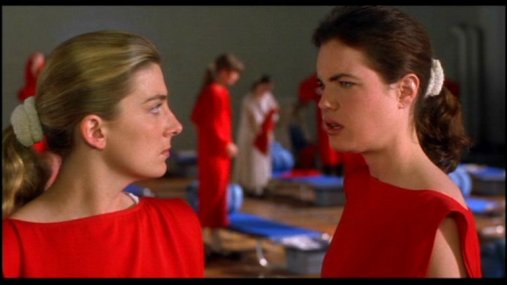We spent time looking at the characters in the novel and you may like to have some extra reading on them. Try this site, you will find detailed notes on all of the important characters. Here’s what they have to say about Moira:
MOIRA
Moira, always known by her own name because she never becomes a Handmaid, is strongly individual, although she is also a type of the female rebel. This is a position which can be viewed in two ways, and both of them are illustrated here. From Offred’s point of view Moira is the embodiment of female heroism, though from the Gileadean authorities’ point of view she is a ‘loose woman’, a criminal element, and her story follows the conventional fictional pattern of such rebellious figures: when Offred last sees her she is working as a prostitute in Jezebel’s. Even here, Moira manages to express her dissidence, for she remains a declared lesbian and her costume is a deliberate travesty of feminine sexual allure, as Offred notices when she meets her again on her night out with the Commander. Moira’s own wryly comic comment on it is, ‘I guess they thought it was me’ (Chapter 38).
Moira, too, is a survivor of the American permissive society, a trendy college student who wears purple overalls and leaves her unfinished paper on ‘Date Rape’ to go for a beer. Much more astute about sexual politics than Offred, she is an activist in the Gay Rights movement, working for a women’s collective at the time of the Gilead coup. When she is brought into the Rachel and Leah Centre she is still wearing jeans and declares that the place is a ‘loony bin’ (Chapter 13). She cannot be terrorised into even outward conformity-, instead she tries to escape and succeeds on her second attempt. She manages to escape disguised as an Aunt. Always funny and ironic, to the other women at the Centre she represents all that they would like to do but would not dare: ‘Moira was our fantasy. We hugged her to us, she was with us in secret, a giggle; she was lava beneath the crust of daily life. In the light of Moira, the Aunts were less fearsome and more absurd’ (Chapter 22).
Moira continues to surface in Offred’s narrative, bobbing up in memory, until her devastatingly fimny final appearance at Jezebel’s. Behind the comedy, however, is the fact that Moira has not managed to escape after all, and as an unregenerate has been consigned to the brothel, where she tells Offred that she has ‘three or four good years’ ahead of her, drinkingand smoking as a Jezebel hostess, before she is sent to the Colonies. Our last view of Moira is on that evening: ‘I’d like her to end with something daring and spectacular, some outrage, something that would befit her. But as far as I know that didn’t happen’ (Chapter 38).
Moira is one of the spirited feminist heroines, like Offred’s mother and Offred’s predecessor in the Commander’s house who left the message scrawled in the closet. The sad fact is these women do get sent off to the Colonies or commit suicide, which Offred herself refuses to do. Offred and Moira are both feminist heroines, showing women’s energetic resistance to the Gilead system, but there are no winners. Neither compromise nor rebellion wins freedom, though it is likely that Offred is rescued by Nick. However, their value lies in their speaking out against the imposition of silence, challenging tyranny and oppression. Their stories highlight the actions of two individual women whose very different private assertions become exemplary or symbolic. Their voices survive as images of hope and defiance to be vindicated by history.
